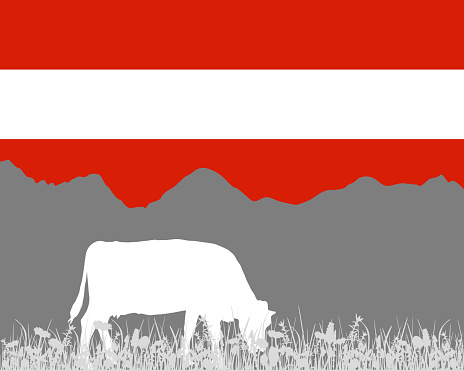This is a list of the cattle breeds from Austria to be wholly or partly of Austrian origin. Some may have complex or obscure histories.
- Ennstaler Bergscheck
- Kärntner Blondvieh
- Murbodner
- Original Braunvieh
- Österreichisches Braunvieh
- Österreichisches Gelbvieh
- Pinzgauer
- Pustertaler Sprinzen
- Tiroler Grauvieh
- Tux-Zillertaler
- Waldviertler Blondvieh
Ennstaler Bergscheck:
The Ennstaler Bergscheck (“Ennstal Mountain Pied Cattle”) is an endangered Austrian breed of domestic cattle. The name comes from the Ennstal, the valley of the Enns River.
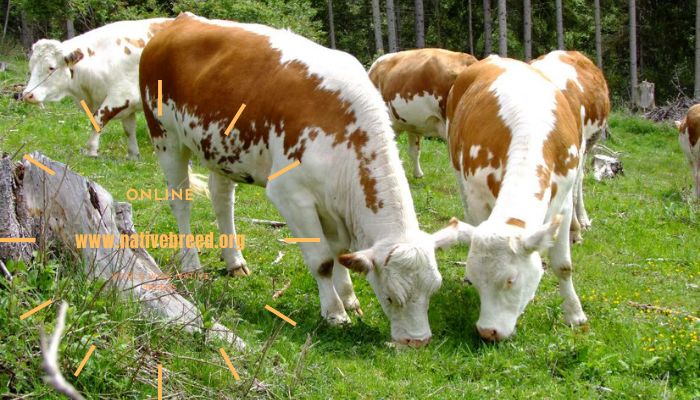
The small light Ennstaler Bergscheck was long believed to have originated from the Bavarian Weißkopfscheck (“White-headed Pied Cattle”) but recent archaeological discoveries indicate descent from the local cattle of the La Tène period (5th–1st centuries BC). Once they were almost totally foxy red before the white spots in their fur increased until 75%–80% of the fur was white with only the loin and the side remaining clouded or with fringed spots. The inner ears are coloured. Horns, hooves and mucosas are mostly pigment free.
The breed was once popular as a draft and beef animal but in the 18th century was replaced by Murboden Cattle, Pinzgau Cattle, or Carinthian Blondvieh. The animals are fully developed after two years in the Alps, so they count as the earliest maturing alpine cattle breed. Although they do not become fat their beef is well-marbled.
It was thought that the last two cows had been slaughtered in 1986, but some surviving animals were found. Their conservation is organised by the Union for the Conservation of Endangered Domestic Animal Breeds (VEGH) and the Austrian National Union for Gene Reserves. In the year 2004, there were in Austria 65 animals in 6 farms again.
Carinthian Blondvieh
Carinthian Blondvieh (German: Kärntner Blondvieh) is an old cattle breed that is native to Carinthia in Austria.
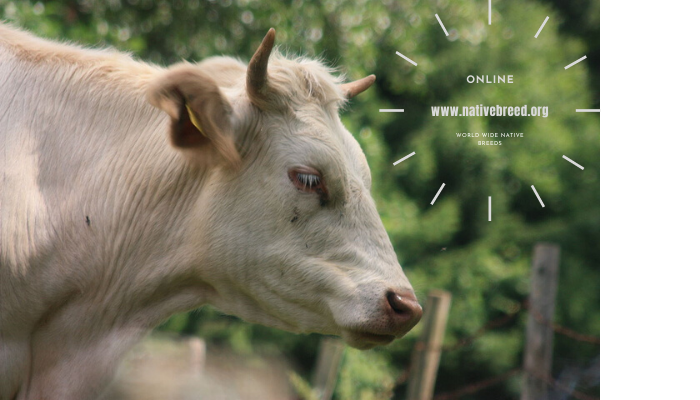
Carinthian Blondvieh is typically uniformly white or pale yellow, with a pale mouth, horns, and hooves. Cows weigh 500 kg (1,100 lb) to 600 kg (1,300 lb), bulls 800 kg (1,800 lb) to 850 kg (1,870 lb). Blondviehs were once bred to be triple purpose cattle, a draft animal as well as a milk and beef producer.
The breed’s date of origin is unknown. Dr. Adolf Gstirner sees the Blondvieh as a descendant of Slovene cattle that came to Carinthia during the early medieval Slavic settlement of the Eastern Alps. They were crossed with Franconian Gelbvieh to develop a new breed which was officially formed by 1890. First recorded in the Carinthian lordship of Eberstein, breeding became common in the Lavanttal and the area around Friesach. A Carinthian Blondvieh breeding association was established in 1924.
Carinthian Blondvieh became a rare breed in the late 20th century when the population decreased sharply to about 100 cattle by 1990. Since then, several efforts have been made for the recovery of stocks
Murbodner
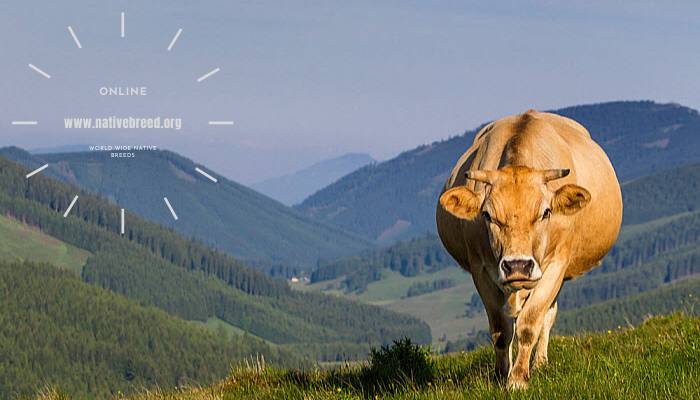
Murboden Cattle are bred primarily in Carinthia, Styria and Lower Austria in Austria, and in the bordering Slovenia. They are a mountain breed used as beef and milk producers, as well as being draught animals. Hair colour varies from yellowish to light red or grey, with deeper red areas around the horns, eyes, and along with the nose. In Slovenia, the breed is called Pomurska, and some small purebred herds have survived.
The breed is a mix of older local mountain breeds, including Murztal Cattle, living in the Mur Valley, Ennstal Mountain Pieds and Carinthian Blondvieh. Breeding for a uniform type began in the early 19th century and a herdbook was established in 1869.
Cows stand 130 to 140 cm and weigh from 700 to 800 kg; bulls are 140 and 150 cm and weigh 1,200 kg.
After World War II the population decreased greatly and there was crossing with other breeds. Only at the beginning of the 1980s were Murboden cattle increasingly bred again, with the Austrian government running a conservation program.
Original Braunvieh
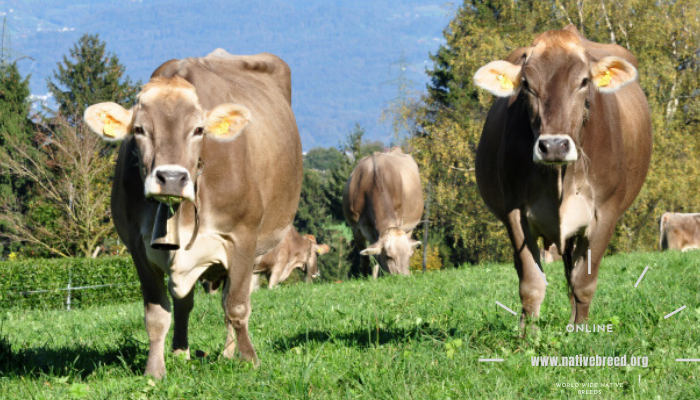
The Original Braunvieh is a dual-purpose dairy and beef breed from Switzerland. Braunvieh means “brown cow” and the animals are coloured grey to brown with white ears and muzzle and have horns. These cattle have been maintained as a pure breed, while the modern Swiss Braunvieh have been crossed with Brown Swiss. They have contributed to the American Brown Swiss breed. In the 1980s breeding associations were formed in Germany and Austria to conserve the breed.
Mature cows weigh approximately 700 kg (1500 lb) and stand 135 to 145 cm (53 to 57 in) tall at the hips. Mature bulls weigh 1000 to 1,100 kg (2200 to 2400 lb) and are 140 to 160 cm (55 to 62 in) tall at the hips.
The most fundamental differences between Original Braunvieh and Braunvieh are lower height, lower milk yield, larger muscles and the better beef performance.
Monks at the Monastery of Einsliedein bred the cattle for several centuries, keeping records showing the breeding principles and early Braunvieh breeding philosophy. The monks kept detailed records and diaries of their breeding principles. Braunvieh cattle exported from Switzerland to the United States between 1869 and 1880 were selected for milk production and formed the basis of the American Brown Swiss breed.
Österreichisches Braunvieh
The Braunvieh is a breed of domestic cattle.

Breeding of this breed began in the 15th century in the Einsiedeln monastery in central Switzerland, from there it spread to Tyrol. Since the mid-1960s, the indigenous population was converted to the current brown cattle by crossing Brown-Swiss bred in America. Except in Switzerland, there east of the Brünig-Napf-Reuss line, the Braunvieh is mainly in South Tyrol, in Austria in Vorarlberg, West Tyrol and Upper Styria and Germany in Swabia and Allgäuheld. The breed without or with very little Brown Swiss crossbreeding is still bred as Original Braunvieh (OBV).
The Braunvieh is a uniformly brown to grey-brown cattle with a black, brightly edged mouth. Its horns are light with a dark tip. The cows weigh approx. 550–750 kg with a withers height of 138–152 cm, bulls approx. 1000–1300 kg. The Braunvieh (also called Brown Swiss) is now a milk-based double-use breed with a high milk yield, which varies depending on the location between 7,200 (mountain regions) and 12,000 litres per year. The daily increases in fattening bulls are 1.2 kg in intensive fattening. Of particular note is the high milk protein content of 3.5 to 4.5 per cent. Braunvieh is number one in many countries in terms of useful life and lifetime performance.
The Braunvieh also includes the Montafon Braunvieh , a cattle breed from southern Vorarlberg.
These are medium-weight, muscular, mostly medium to dark brown animals with light eels. Cows weigh approx. 500–600 kg, bulls approx. 750–1000 kg. The Montafon were widespread in the 19th century and were then increasingly converted from brown Swiss to brown cattle.
Österreichisches Gelbvieh
The Gelbvieh cattle are a tall-growing, long, horned cattle with good muscles and strong bones. They are solid yellow and generally have a bright, but sometimes a dark muzzle.
The Gelbvieh is a dual-purpose beef breed and they are used in other countries especially as beef cattle. This breed is characterized by its fast growth, feed efficiency, early maturity and longevity. The carcass has superior quality and a high dressing percentage. The meat is fine-fibrous, tender and well-marbled.
Beginning of the 19th century: Introduction of Heilbronner cattle, a cross between “Rotem Landvieh” and “Rotbraunem Berner Vieh”, in Franconia in Germany
1870: Large variety of breeds with the predominance of yellow-brown breeds
1872: Formation of a clear breeding goal; the yellow Franconian cattle were created by crossbreeding Simmentaler, South- Devons and Shorthorns
Pinzgauer cattle
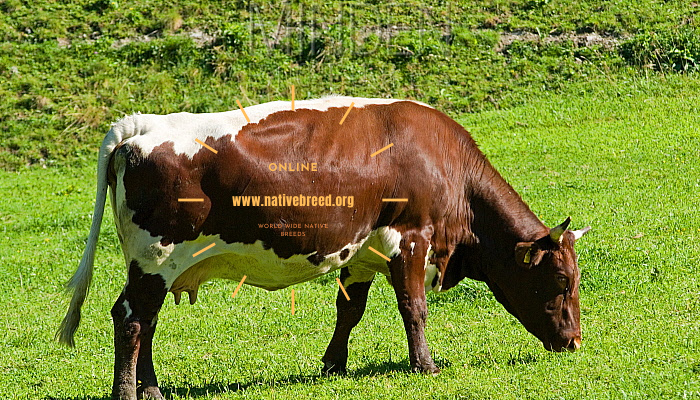
The Pinzgauer is a breed of domestic cattle from the Pinzgau region of the federal state of Salzburg in Austria. It has distinctive colouring, with chestnut-brown sides and white back and underside. It was in the past a triple-purpose breed, raised for meat, milk and draught use. There is a naturally polled sub-type, the Jochberg Hummel. In 2007 the breed was not considered by the FAO to be at risk.
According to genetic and morphological studies, the Pinzgauer cattle breed is most closely related to North German lowland breeds.
The Pinzgauer was first referred to as a breed in 1846, and before this called “Pinzgauer Fasel” or “Pinzgauer Schlag”. In the 19th century, they were bred into strong stock for work on farms, at breweries, and in sugar-beet areas. In its heyday, the Pinzgauer became the most popular cattle breed in Austria-Hungary, subsequently expanding through Eastern Europe. The Bavarian Pinzgauer Cattle Breeding Association was founded in 1896. By December 1890, the Pinzgauer population had grown to 101,880 in Bavaria, but it eventually collapsed as a result of industrialization after World War I. Demand for the cattle decreased, and the breed was replaced by better milk-producing breeds such as Fleckvieh cattle. By 1930, Bavaria had only 85,000 Pingzauer cattle.
A naturally polled type, the Jochberger Hummel, was considered a separate breed until 1997 when it was merged into the Pinzgauer herd book. These cattle descend from a single, almost white calf that was born in 1834 in Tyrol. They were considered crippled and useless because they could not put on a yoke. Now Pinzgauer is not yoked, and the hornless breed is well adapted to modern husbandry. There are now fewer than 50 hornless Pinzgauer cattle in the world, so the type is endangered. Since 1988, there have only been two hornless bulls at the insemination station near Salzburg.
The animals are auburn. A luscious chestnut-colour is the breeding target. Black animals have occurred, but rarely, and were once seen as a curse. After 1900, black bulls were removed from the breeding system, and the black colour vanished. All Pinzgauers have the typical finched pattern in common: a broad white stripe lengthwise along the whole back. The abdomen, chest, udder, and tail are white as well.
The weight of cows ranges from 600 to 700 kg, and cows average 137 cm in height. Bull weight ranges from 1000 to 1100 kg, and bull height is 147 cm on average.
Pustertaler Sprinzen
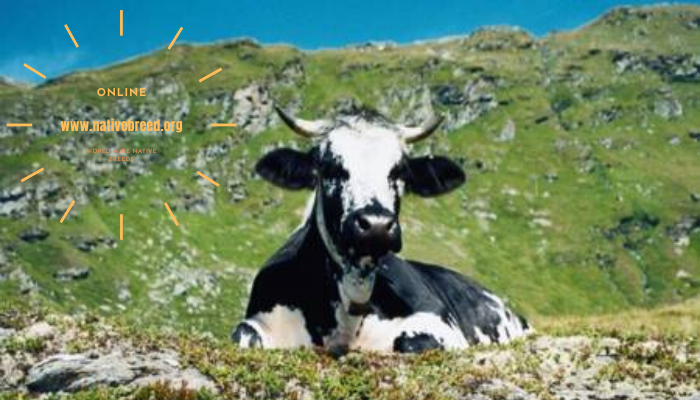
The Pustertaler Sprinzen, also called Pustertaler or Pustertaler Schecken, is a rare breed of cattle from the Puster Valley in the autonomous province of Bolzano, now in north-eastern Italy. Genetic research carried out in 2001 showed the Barà breed of the province of Turin to be closely similar to the Pustertaler; the two populations have since 2002 been treated and registered as a single breed. It is one of the sixteen minor Italian cattle breeds of limited diffusion recognised and protected by the Ministero Delle Politiche Agricole Alimentari e Forestali, the Italian Ministry of agriculture.
Pustertaler cattle originate from an area that includes the Pustertal and its tributary valleys, and the eastern parts of the Eisacktal or Isarco valley. Following the construction of the Pustertal railway in the 1860s, hundreds of head were bought and loaded at Bruneck for transport north of the Alps, particularly to the area of Vienna, where the Pustertaler came to be known as the Wiener Kuh, or Viennese cow. The Pustertaler was highly esteemed for its milk and commanded high prices. A herd-book was opened in 1900, and several breeder associations formed in the next few years. However, some Pustertal farmers replaced the animals they had sold with cheaper stock from Carinthia, which led to a decline in quality. The First World War and the cession of South Tyrol to Italy under the Treaty of Saint-Germain of 1919 led to a decline in numbers also, and the herd-book was not maintained after 1920. After the ending of inspection for bull licensing through a Decree of the Agrarian Inspectorate in 1927, the cattle breed collapsed. An attempt to revive the fortunes of the breed was made between 1954 and 1967; approximately 300 cows and 500 calves were registered during this period. Italian regional cattle breeds of limited diffusion, including the Pustertaler, came under ministerial protection in 1985. Responsibility for registration of these breeds was delegated to the Associazione Italiana Allevatori, the national breeders’ association, in 1991. Between 1983 and 2002 breed numbers remained low; numbers in 2002 were variously estimated at 635 head (with less than 100 cows registered); and at about 200.
A genetic study carried out in 2001 showed that the local breed known in the provinces of Turin and Cuneo as the Barà (dialect for barrato, “barred”) was closely similar to the Pustertaler. The two populations have since 2002 been treated and registered as a single breed. The Barà race numbered several thousand, so overall breed numbers increased substantially. A total population of 3321 head was reported in 2009.
The cattle are finched and colour-sided: they are white with chestnut-brown to light brown or black plaques on the flanks that dissolve into small spots at the margins. They have short spreading or forward-pointing horns. The cows weigh 500–650 kg and average 130 cm tall at the withers, the bulls 800–900 kg and about 140 cm tall.
The breed is reared in Austria, Germany, Italy and South Africa.
Tyrol Grey
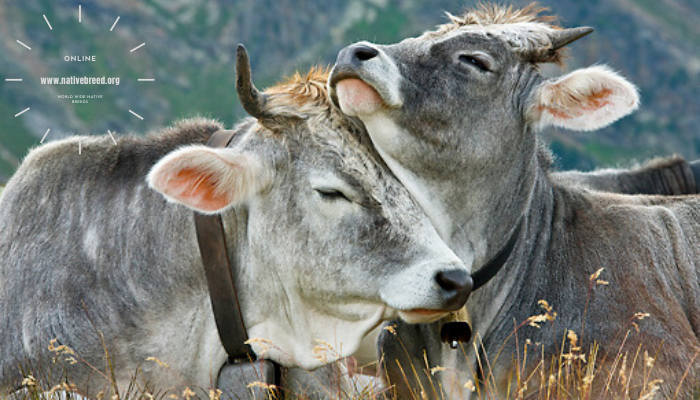
The Tyrol Grey or Tyrolean Grey (German: Tiroler Grauvieh, Italian: Grigio Alpina) is a typical alpine cattle breed from Tyrol in Austria and South Tyrol in Italy. It’s a dual-purpose breed with very good milk and beef performance. The females grow up to their full size within three years and reach a weight of 550 – 600 kg. They have a correct fundament and hard claws.
The Tyrol Greys have a good forage instinct and feed conversion. They are also robust, long-living, and very fertile.
The milk has excellent quality and is adequate either for the direct consumption or the processing to high-quality products (cheese, butter, yoghurt). Among the mountain cattle breeds in Italy, the Tyrol Grey has the best milk amount/milk quality (fat, protein) ratio and delivers a higher amount of contents for the processing to quality products. The above-average per cow was 2002 in the South Tyrol about 4,836 kg milk per annum, 3.78% milk fat content, and 3.38% protein (8,491 control cows). When you evaluate the performance you have to allow for the middle body weight and the tough feeding and husbandry conditions in mountain regions.
The Tyrolean Grey cattle are a dual-purpose breed for milk and beef and possess an excellent mast ability and beef quality.
The breeding purpose is the advancement of milk and beef quantity and quality. Furthermore, it is the purpose to conserve the typical functional attributes of the breed: middle body height, robust constitution, correct fundament, hard claws, hardiness, mountain pasture competence, good fertility, easy calving, udder quality and good milk ability.
Tux-Zillertal
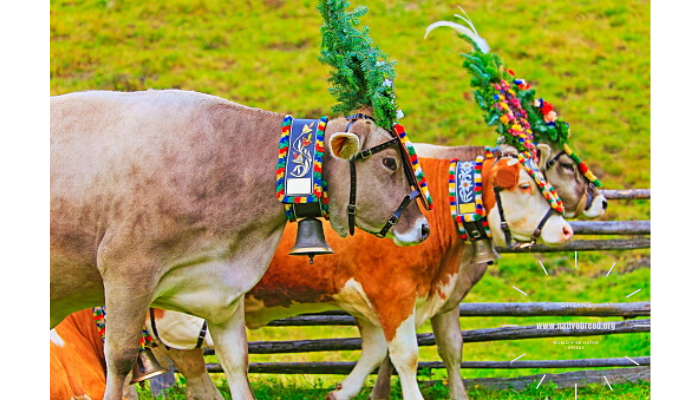
The Tux-Zillertal, German: Tux-Zillertaler, is an endangered Austrian breed of domestic cattle. It was created in 1982 when two similar Alpine breeds, the Tux and the Zillertal, were merged.:317 The two names derived from those of the municipality of Tux in the Tuxertal, and the neighbouring Zillertal, both in the Tirol region of Austria. The Tux-Zillertal may derive from the Swiss Hérens breed. Like the Hérens, it was long selected for the fighting ability of the cows, at the expense of productive characteristics.
The Tux-Zillertaler breed was created in 1982 by merging the remaining populations of the two similar Alpine breeds, the Tux and the Zillertal. Both breeds are similar to the Hérens breed of Switzerland and are sometimes thought to have derived from it.:116 The Tux breed was formerly common in Tyrol and other parts of Austria. Today it is kept mainly in the In 1930 there was some 4500 head. By 1970 the number had fallen to 30, and systematic conservation efforts were begun.:77 A study in 2002 found a total population of 471 head:175 In 2014 a population of 1117–2500 was reported.
The Tux-Zillertal is of medium size, powerfully built with a strong neck and strong black-tipped horns.:77 The coat is black or red, with white markings on the pelvis, the root of the tail, the underbelly and on the udder. The black colour derives from the Tux breed, and the red from the Zillertal.:76 The skin is dark, the nose and hooves black.:77 The Tux-Zillertal is a frugal breed, well adapted to high mountain pastures.
Waldviertler Blondvieh
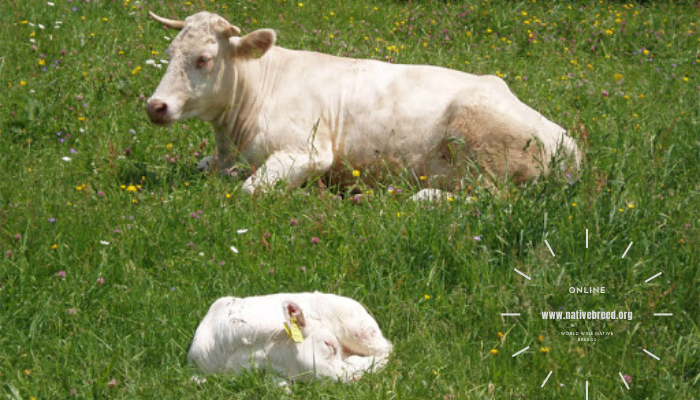
The Waldviertler Blondvieh is small-framed, long-lived and, especially in terms of milk yield, a late-ripened cattle with a narrow body, delicate bone structure and average muscularity. The colour of the animals is almost white, light blonde to bread-coloured with flesh-coloured mouth and yellow-brown horns and claws.
This breed is one of the meat-stressed dual-use cattle. The very fine-grained meat, combined with good fertility and easy calving of the cows, make the Waldviertler Blondvieh the ideal breed for suckler cattle for the production of quality meat on less productive soils.
